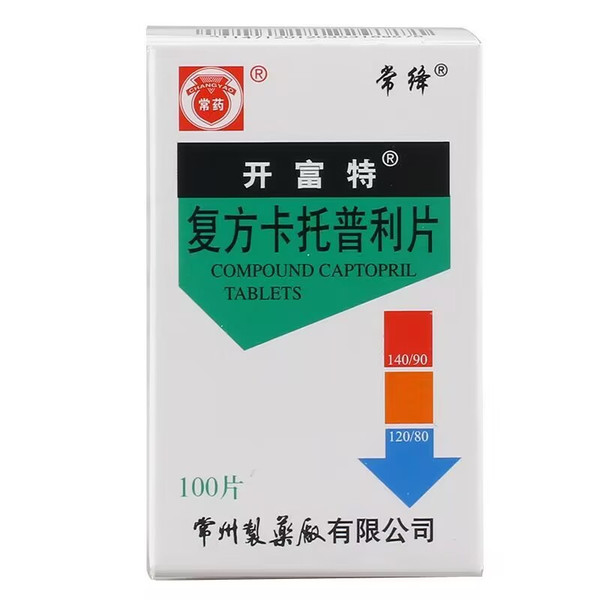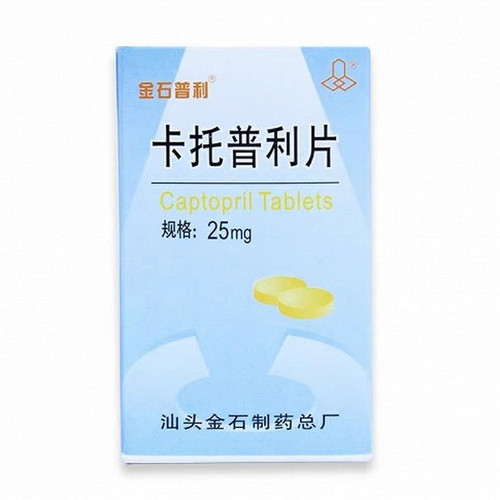Product Overview
[Drug Name]
Generic Name: Compound Captopril Tablets
Trade Name: Kaifu Te
English Name: Compound Captopril Tablets
Chinese Pinyin: Fufang Katuopuli Pian
[Ingredients]
This product is a compound preparation, its components are: (1) Captopril 1-[(2S)-2-toluene-3-mercapto-1-oxypropyl]-L-proline; (2) Hydrochlorothiazide 6-chloro-3,4-dihydro-2H-1,2,4-phenylthiadiazine-7-sulfonamide-1,1-dioxide.
[Properties]
This product is a white or off-white tablet in the form of a sugar-coated tablet. After removing the sugar coating, it appears white or off-white.
[Indications]
1. Hypertension, can be used alone or in combination with other antihypertensive drugs. 2. Heart failure, can be used alone or in combination with cardiotonic and diuretic drugs.
[Usage and Dosage]
Depends on the condition or individual differences. This product should be taken under the guidance or supervision of a physician. The dosage should be individualized and adjusted according to the efficacy.
1 Common dosage for adults
(1) For hypertension, take 12.5 mg orally once, 2-3 times a day. Increase to 50 mg 2-3 times a day within 1-2 weeks as needed. If the efficacy is still unsatisfactory, other antihypertensive drugs can be added.
(2) For heart failure, start with 12.5 mg orally once, 2-3 times a day. If necessary, gradually increase to 50 mg 2-3 times a day. If further increase is needed, observe the efficacy for 2 weeks before considering it. For patients who have recently taken a large amount of diuretics and are in hyponatremia/hypovolemia, but have normal or low blood pressure, the initial dose should be 6.25 mg 3 times a day. Then gradually increase to the common dosage after testing.
2 Common dosage for children: For both antihypertensive and heart failure treatment, start with 0.3 mg/kg of body weight, 3 times a day. If necessary, increase by 0.3 mg/kg every 8-24 hours to obtain the lowest effective dose.
Adverse Reactions: 1. Common adverse reactions include: (1) Rash, which may be accompanied by itching and fever. It often occurs within 4 weeks of treatment and is maculopapular or urticarial. It disappears after dose reduction, discontinuation of the drug, or administration of antihistamines. 7% to 10% are accompanied by eosinophilia or positive antinuclear antibodies. (2) Palpitations, tachycardia, and chest pain. (3) Cough. (4) Taste loss. 2. Less common adverse reactions include: (1) Proteinuria, which often occurs within 8 months of treatment. One-quarter of patients develop nephrotic syndrome, but proteinuria gradually decreases within 6 months and is not affected by the course of treatment. (2) Dizziness, headache, and syncope. These are caused by hypotension, especially in the presence of sodium deficiency or hypovolemia. (3) Angioedema, which occurs on the face, hands, and feet. (4) Rapid and irregular heart rate. (5) Facial flushing or pallor. 3. Rare symptoms include: leukopenia and granulocytopenia, fever, chills. Leukopenia is dose-related and occurs 3-12 weeks after the start of treatment, is most significant 10-30 days later, and lasts for 2 weeks after discontinuation of the drug.
[Contraindications]
This product is contraindicated in patients who are allergic to this product or other angiotensin-converting enzyme inhibitors.
[Precautions]
1. Food in the stomach can reduce the absorption of this product by 30-40%, so it is advisable to take the drug 1 hour before meals. 2. This product can increase blood urea nitrogen and creatinine concentrations, which is often temporary. It is more likely to occur after a rapid drop in blood pressure in patients with kidney disease or long-term severe hypertension. Occasionally, serum liver enzymes may increase; it may increase blood potassium. When used in combination with potassium-sparing diuretics, blood potassium should be checked. 3. This product should be used with caution in the following situations: (1) Autoimmune diseases such as severe systemic lupus erythematosus, in which case the chance of leukopenia or granulocytopenia increases. (2) Bone marrow suppression. (3) Insufficient blood supply to the cerebral artery or coronary artery, which may aggravate ischemia due to decreased blood pressure. (4) Hyperkalemia. (5) Renal dysfunction leading to increased potassium, decreased white blood cells and granulocytes, and the retention of this product. (6) Aortic valve stenosis, which may reduce coronary artery perfusion. (7) Patients with strict dietary sodium restriction or dialysis may experience sudden and severe hypotension after the first dose of this product. 4. Follow-up examinations during the use of this product: (1) White blood cell count and differential count, once every 2 weeks for the first 3 months, and then regularly, and immediately if there are signs of infection. (2) Urine protein test once a month. 5. Patients with poor renal function should use a small dose or reduce the number of doses, and increase slowly; if diuretics must be used at the same time, furosemide is recommended instead of thiazides. When blood urea nitrogen and creatinine increase, reduce the dose of this product or stop the diuretic at the same time. 6. If proteinuria gradually increases while using this product, suspend this product or reduce the dosage. 7. If the white blood cell count is too low while using this product, suspend this product and it may recover. 8. If angioedema occurs while using this product, discontinue use and promptly administer 0.3-0.5 ml of 1:1000 epinephrine subcutaneously. 9. Use with caution in athletes.
[Use in Special Populations]
Precautions for Children:
This product has been reported to cause an excessive and prolonged decrease in blood pressure, accompanied by oliguria and seizures, in infants. Therefore, its use is limited to those who have failed other antihypertensive treatments.
Precautions for Pregnancy and Lactation:
1. This product crosses the placenta. Absorption of angiotensin-converting enzyme inhibitors by pregnant women may affect fetal development or even cause fetal death. Therefore, this product is contraindicated in pregnant women. 2. This product is excreted in breast milk at concentrations approximately 1% of the maternal blood concentration. Therefore, use in lactating women requires careful consideration of the risks and benefits.
Precautions for the Elderly:
The elderly are more sensitive to antihypertensive effects; therefore, the dosage of this product should be reduced as appropriate.
[Drug Interactions]
Concomitant use with diuretics may enhance the antihypertensive effect, but severe hypotension should be avoided. Therefore, patients currently taking diuretics should discontinue or reduce their dosage. This product should be started with a low dose and gradually adjusted. 1. Concomitant use with other vasodilators may cause hypotension; if appropriate, the dose should be started at a low level. 2. Concomitant use with potassium-retaining drugs such as spironolactone, triamterene, and amiloride may cause hyperkalemia. 3. Concomitant use with endogenous prostaglandin synthesis inhibitors such as indomethacin will weaken the antihypertensive effect of this product. 4. Concomitant use with other antihypertensive drugs may enhance the antihypertensive effect. It exhibits an additive effect with drugs that induce renin release or affect sympathetic activity, and a less-than-additive effect with beta-blockers.
[Pharmacological Actions]
Captopril primarily inhibits angiotensin-converting enzyme activity, reducing angiotensin II levels, decreasing aldosterone secretion, and dilating arteries and veins, achieving a blood pressure-lowering effect and reducing cardiac preload and postload, thereby improving cardiac function. Hydrochlorothiazide primarily increases renal excretion of sodium chloride, resulting in a diuretic effect, which reduces blood volume and exerts a blood pressure-lowering effect.
[Storage] Store in a dark, airtight container in a dry place below 30°C. [Packaging Specifications] 100 tablets/bottle
[Expiration Period] 24 months
[Approval Number] National Medicine Standard H10900049
[Manufacturer] Company Name: Changzhou Pharmaceutical Factory Co., Ltd.








